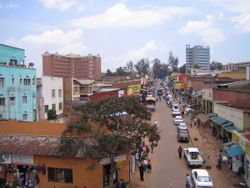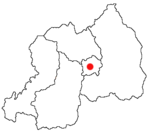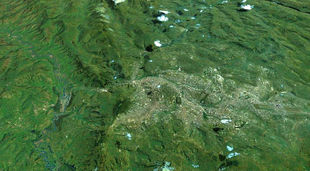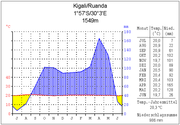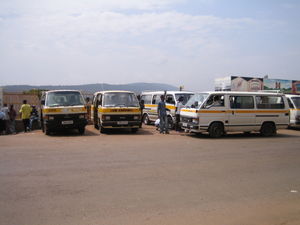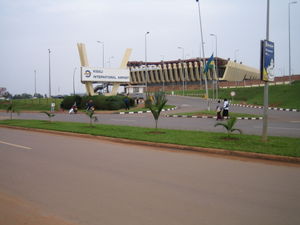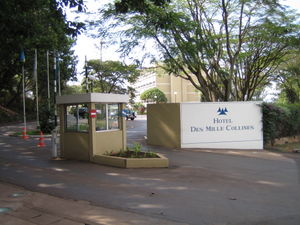Kigali
2007 Schools Wikipedia Selection. Related subjects: African Geography
| Kigali, Rwanda | |
| Kigali, Rwanda | |
| Map of Rwanda showing the location of Kigali. | |
| Coordinates: | |
|---|---|
| Province | Kigali City |
| Mayor | Aisa Kirabo Kacyira |
| Area | |
| - City | km² |
| Population | |
| - City (2005) | 851,024 |
| - Urban | 851,024 |
| estimated | |
| Time zone | CAT ( UTC+1) |
| - Summer ( DST) | none ( UTC+1) |
| Website: http://www.kigalicity.org | |
Kigali, population 851,024 ( 2005), is the capital and largest city of Rwanda. It is situated in the centre of the nation, and has been the economic, cultural, and transport hub of Rwanda since it became capital at independence in 1962. The main home and offices of the Rwandan president, Paul Kagame, are located in the city, as are the government ministries. The city is coterminous with the province of Kigali City, which was enlarged in January 2006 as part of local government reorganisation in the country.
History
Kigali was founded in 1907 under German colonial rule, but did not become the capital until Rwandan independence in 1962. The traditional capital was the seat of the mwami (king) in Nyanza, while the colonial seat of power was in Butare, then known as Astrida. Butare was initially the leading contender to be the capital of the new independent nation, but Kigali was chosen because of its more central location. Since then the city has grown very quickly and is now the major political, economic and cultural centre of Rwanda.
Beginning on April 7, 1994, Kigali was the scene of the Rwandan Genocide — the slaughter of approximately one million Tutsis and moderate Hutus by Hutu militias ( interahamwe), and some members of the Rwandan army — and of fierce fighting between the army (mostly Hutu) and Tutsi-dominated Rwandese Patriotic Front. Although damaged, the city's structure has recovered.
Geography
The city is built in hilly country, sprawling across about four ridges and the valleys in between. The city centre is located on one of these ridges, with the main government area on another. The tops of the ridges have an average elevation of 1,600m (5,246ft) while the valleys are around 1,300m (4,270ft). The bigger houses and office buildings tend to be on the tops of the ridges, while the poorer people live in the valleys. The city is ringed most of the way round by higher hills, with some suburban sprawl rising up these. The highest of these is Mt. Kigali, with an elevation of 1,850m (6,075ft) above sea level.
Economy
Tin ore ( cassiterite) is mined nearby, and the city built a smelting plant in the 1980s. Business in Rwanda is growing, and many new buildings are emerging across the city, including the BCDI tower and the Centenary House office block. Tourism and expatriate NGO workers provide important input into the economy also.
Transportation
Airports
The city is home to an international airport, Kigali International Airport, with passenger connections daily to Nairobi and less frequently to Addis Ababa, Brussels, Bujumbura and Johannesburg. There are also weekly cargo flights to Amsterdam. There is also one domestic air route from Kigali, to Cyangugu in the far south-west. The airport is somewhat limited by its location on the top of a hill, and a brand new one is being considered in the Nyamata area, some 40km from Kigali.
International
There are several daily coach services which depart from Kigali to destinations in East Africa. Most leave from the Nyabugogo bus station. These services include:
- Jaguar Executive Coaches, which connects Kigali to Kampala, the Ugandan capital, via Gatuna or via Kayonza and Kagitumba.
- Regional Coach Services, which runs services to Kampala (8 hours), Nairobi, Kenya (20 hours) and Dar es Salaam, Tanzania (36 hours). These buses are usually air-conditioned.
- Onatracom Express - a Rwandan government service using quite basic buses, running between Kigali and Kampala.
- Yahoo Car Express - A minibus service running between Kigali and Bujumbura, Burundi.
In addition the national express share taxi services to Gisenyi and Cyangugu often cross the DRC border to carry passengers to Goma and Bukavu respectively.
National
Kigali is the hub of the Rwanda transport network, with hourly express bus routes to all major towns in the country. The major nationwide companies are Okapi Car, Atraco, Stella, Omega (minibuses), and Onatracom, which offers a big bus service, while Volcano Express (to Butare), Virunga Express (to Ruhengeri), Muhabura Express (to Ruhengeri and Gisenyi) serve specific destinations. There are also taxi minibus services ( matatus) leaving from Kigali, which also go through to the major towns, but which stop frequently along the route to pick people up and set them down. These services do not run to a fixed timetable, and one often has to wait an hour or more for them to fill up before departing.
Local
Public transport within Kigali is exclusively by taxi minibus ( matatu), with a number of different routes, connecting the main hubs of Mu Mujyi (the city centre), Nyabugogo, Kacyiru, Kimironko and Remera. Similar to the national taxi minibuses, these services wait to fill up before setting off from the terminus, then pick up and drop off frequently en route. Most routes within the city operate on a flat fare of 150 FRW (about US $0.25).
Private hire
Kigali has many taxis (known as 'special hire' or 'taxi voiture'), which are generally white with an orange stripe down the side. Fares vary from 1000 FRW ($1.75) up to 2500 FRW ($4.50) for a journey right across the city. There are also motorbike taxis ('taxi moto'), which offer a service similar to a taxi, but for lower prices, typically in the range 200-1000 FRW.
Points of Interest
The city now has three international class hotels, built as part of the country's bid to increase tourism and better support business travellers:
- The Mille Collines in the Kiyovu area. This hotel became a refugee centre during the genocide, as famously depicted in the film Hotel Rwanda (although the hotel shown in the film is in fact in South Africa). It is also the setting for the famous novel Un dimanche à la piscine à Kigali, by Quebecer Gil Courtemanche, and its movie adaptation Un dimanche à Kigali.
- The Novotel Umumbano in the Kacyiru area. This was formerly a Le Meridien hotel, then known as Le Meridien Umumbano. It was bought by Novotel after the genocide.
- The InterContinental Kigali. Formerly a Belgian-owned hotel, known then as Les Diplomates, this splendid and original Hotel was also - albeit briefly - portrayed in the second half of Hotel Rwanda. It was later bought by the InterContinental Hotels group, and extensively remodelled in 2003.
There are also several memorials, museums, and centers dedicated to the Rwandan Genocide including the Kigali Genocide Memorial Centre.
